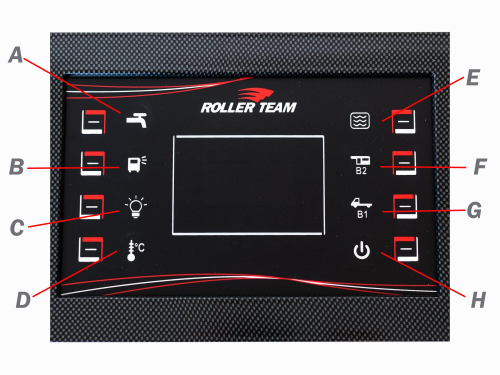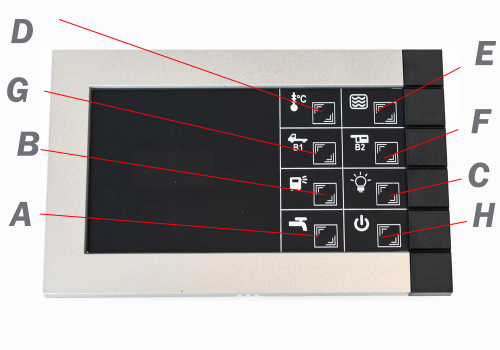Roller Team Control Panel (SWLS488)

-
A - (Water Pump)
Water pump on/off
When it comes to managing resources in a motorhome, the decision of whether to leave the water pump on or off is an important consideration, each with pros and cons.
Pros
-
Immediate Access to Water: Keeping the water pump on ensures that you have instant access to running water whenever you need it. This is particularly useful for activities such as washing hands, cooking, and cleaning dishes.
-
Convenience: With the water pump on, you won't have to repeatedly switch it on and off each time you require water. This can make daily tasks more efficient and reduce the hassle of constant adjustments.
-
Prevention of Contamination: Leaving the pump on can prevent the growth of bacteria and mold in the water lines. The constant circulation of water discourages stagnation and helps maintain better water quality.
Cons
-
Power Consumption: Keeping the water pump running continuously can lead to increased power consumption, potentially draining the motorhome's battery more quickly. This could be a concern, especially if you're wildcamping or camping without access to electrical hookups.
-
Noise: Water pumps can be noisy, and leaving it on might contribute to a constant background noise inside the motorhome. This could be a nuisance, particularly during quiet times or while sleeping.
- Possible flooding: In the event of a burst pipe or water leak the pump will be able leak all available water
-
-
B - (External Light)
This is just an on / off switch for the outside light, normally positioned just above the habitation door to allow an inviting entrance or often used to illuminate under the awning area in the evening.
-
C - (Internal Lights)
This is just an on / off switch for the inside lights. Please note that this also activates the 12-volt supply used in many other power sully points within the habitation area, for example the TV points, if running on 12-volts. In many cases this is left on well using your motorhome and the lights would be controlled by their own switches.
-
D - (Internal / external Temperature)
- Press button to display the internal temperature (IN).
- Press it once again to display the external temperature (OUT).
- If "OPT" (optional) appears, the extenal sensor is not present. If the temperature sensor is faulty, "-" will appear.
- The display will remain visable for about 30 seconds
-
E - (Fresh - Waste Water Levels)
- Press the button several times to display in % the levels of the relitive tank identified by symbols S1, R1, R2.
- If S1 is empty or R1, R2 are full, the display will flash. If the connection to the tank is faulty, "--" will be displayed
- S1 = Fresh Water
- R1 = Waste Tank 1
- R2 = Waste Tank 2 (not on all motorhomes)
- The display will remain visable for about 30 seconds
-
F - (Habitation Battery)
- Push this button once to display the service (habitation) battery voltage
- Press again to display in % remain charge
- The display will remain visable for about 30 seconds
-
G - (Vehicle Battery)
- Push this button once to display the start-up (vehicle) battery voltage
- Press again to display in % remain charge
- The display will remain visable for about 30 seconds
-
H - (On/Off)
- Press once to turn on
- Press again to turn off
Roller Team Control Panel (SWLS1123)
-

This symbol appears when the motorhome is traverlling with two batteries coupled
-

This symbol turns on when a diverter NE 185 fuse has blown
-

The symbol appears when the 230V supply is present (connected to EHU and you have power)

-
A - (Water Pump)
Water pump on/off
When it comes to managing resources in a motorhome, the decision of whether to leave the water pump on or off is an important consideration, each with pros and cons.
Pros
-
Immediate Access to Water: Keeping the water pump on ensures that you have instant access to running water whenever you need it. This is particularly useful for activities such as washing hands, cooking, and cleaning dishes.
-
Convenience: With the water pump on, you won't have to repeatedly switch it on and off each time you require water. This can make daily tasks more efficient and reduce the hassle of constant adjustments.
-
Prevention of Contamination: Leaving the pump on can prevent the growth of bacteria and mold in the water lines. The constant circulation of water discourages stagnation and helps maintain better water quality.
Cons
-
Power Consumption: Keeping the water pump running continuously can lead to increased power consumption, potentially draining the motorhome's battery more quickly. This could be a concern, especially if you're wildcamping or camping without access to electrical hookups.
-
Noise: Water pumps can be noisy, and leaving it on might contribute to a constant background noise inside the motorhome. This could be a nuisance, particularly during quiet times or while sleeping.
- Possible flooding: In the event of a burst pipe or water leak the pump will be able leak all available water
-
-
B - (External Light)
This is just an on / off switch for the outside light, normally positioned just above the habitation door to allow an inviting entrance or often used to illuminate under the awning area in the evening.
-
C - (Internal Lights)
This is just an on / off switch for the inside lights. Please note that this also activates the 12-volt supply used in many other power sully points within the habitation area, for example the TV points, if running on 12-volts. In many cases this is left on well using your motorhome and the lights would be controlled by their own switches.
-
D - (Internal / external Temperature)
- Press button to display the internal temperature (IN).
- Press it once again to display the external temperature (OUT).
- If "OPT" (optional) appears, the extenal sensor is not present. If the temperature sensor is faulty, "-" will appear.
- The display will remain visable for about 30 seconds
-
E - (Fresh - Waste Water Levels)
- Press the button several times to display in % the levels of the relitive tank identified by symbols S1, R1, R2.
- If S1 is empty or R1, R2 are full, the display will flash. If the connection to the tank is faulty, "--" will be displayed
- S1 = Fresh Water
- R1 = Waste Tank 1
- R2 = Waste Tank 2 (not on all motorhomes)
- The display will remain visable for about 30 seconds
-
F - (Habitation Battery)
- Push this button once to display the service (habitation) battery voltage
- Press again to display in % remain charge
- The display will remain visable for about 30 seconds
-
G - (Vehicle Battery)
- Push this button once to display the start-up (vehicle) battery voltage
- Press again to display in % remain charge
- The display will remain visable for about 30 seconds
-
H - (On/Off)
- Press once to turn on
- Press again to turn off
-

This symbol appears when the motorhome is traverlling with two batteries coupled
-

This symbol turns on when a diverter NE 185 fuse has blown
-

The symbol appears when the 230V supply is present (connected to EHU and you have power)
Other Roller Team Control Unit Information
-
Control Panel - NE268, NE269, NE185
-
Control Panel - NE100
-
Control Panel - NE196
-
Control Panel - NE185, 154, 152, 188, 148, 185, 143 - Wiring Diagram
-
Control Panel - NE268, 269, 185 Manual


